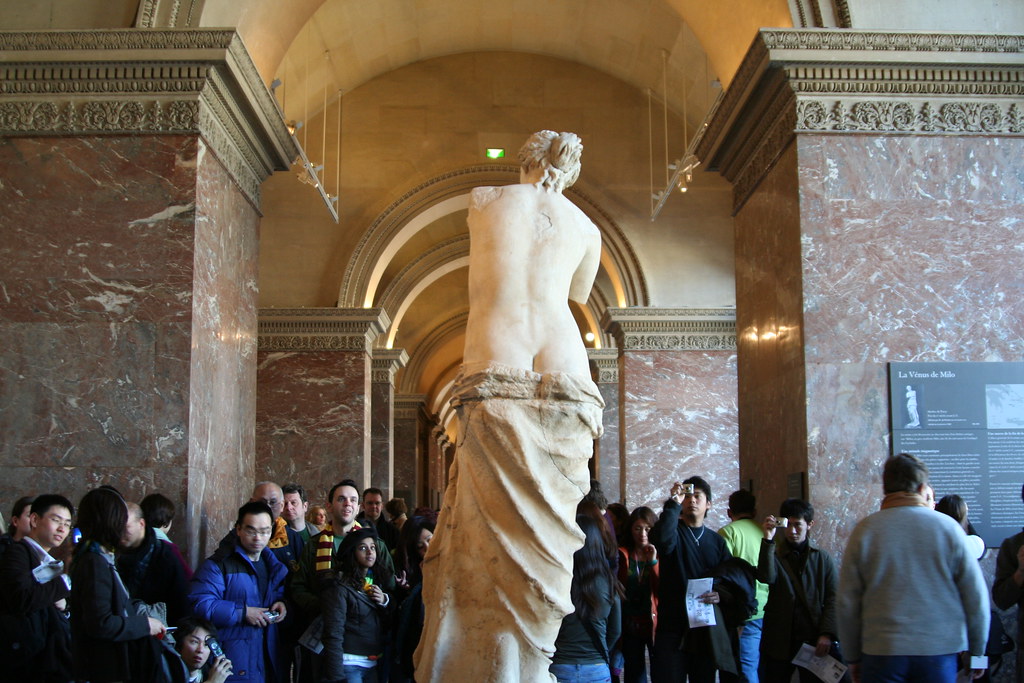Elements of Art Used in Venus Medici De Sculpture
Every bit one of fine art history'due south nigh meaning sculptures, the Venus de Milo continues to captivate audiences today. Located in the Louvre Museum, the marble masterpiece is celebrated for its Hellenistic artistry, renowned for its beauty, and famous for its absent artillery.
Like many other treasured antiquities, the story behind the statue was entirely unknown when it was unearthed in the 19th century. Today, however, archaeologists and art historians have managed to piece together a narrative that explores and explains its possible provenance—though the sculpted goddess remains shrouded in mystery.
What is the Venus de Milo?
Known as well as the Aphrodite of Milos , the Venus de Milo is a marble sculpture that was likely created past Alexandros of Antioch (2nd – 1st century BCE)–a Greek sculptor from the Hellenistic period—during the late second century BCE. It features a near nude, larger-than-life (half-dozen feet, viii inches tall) female figure posed in a classical S-curve.
Her body is composed of two blocks of Parian marble also equally "several parts [that] were sculpted separately (bust, legs, left arm, and foot)," co-ordinate to the Louvre. Furthermore, the sculpture was likely colorfully painted and adorned with jewelry, though no paint or metal remains on the marble today.
Who is Venus de Milo?
Since the statue was discovered without its arms, it is nearly impossible to confirm with accented certainty who Venus de Milo is supposed to correspond as near sculptures of gods and goddesses from this catamenia contained symbolism of who they were in what was in their hands. Fifty-fifty then, art historians have ii strong theories, of which the strongest and most popular is that she is supposed to be Venus, goddess of beloved (the Roman analogue to Aphrodite).
However, she may likewise represent Amphitrite—the goddess of the ocean—who held special significance on the Greek island of Melos, where the work of art was found. The statue was even discovered virtually a Parian marble apple—the same fabric every bit the sculpture—which is one of Amphitrite's symbols.
Discovery
In 1820, the statue was discovered by a farmer in an ancient niche on the Aegean island of Melos. While information technology was unearthed in pieces, information technology was able to exist reassembled. Its fragmented arms—the left property an apple and the right brushing confronting the effigy'due south waist—nevertheless, were deemed unoriginal and not re-attached.
Additionally, as evident in this drawing by Jean-Baptiste-Joseph Debay, the figure was establish on an inscribed base of operations, which also proved to be a later addition and was thus removed.
Still, even equally an incomplete sculpture, it was immediately considered a masterpiece. It was given to Louis XVIII, who donated information technology to the Louvre in 1821. While the museum initially intended to restore the statue, no ane could make up one's mind how to position its artillery. "Leaning confronting a pillar, resting her elbow on Ares' shoulder, or holding a variety of attributes" are some of the many possibilities that could accept characterized the statue'due south original design.
Given the Louvre'southward inability to agree upon the sculpture's intended aesthetic, it was put on display without its arms—a decision that nevertheless stands.
The Sculpture Today
For nigh 200 years, the sculpture has been a vital function of the Louvre'due south permanent collection. Along with pieces like Leonardo da Vinci's Mona Lisa and Michelangelo'due south Dying Slave, it is regarded as one of the museum'due south most precious—and popular—works of art.
Described by the Louvre equally a "timeless masterpiece," the Venus de Milois slated to brainwash and enchant for centuries to come.

This article has been edited and updated.
Related Articles:
How a Single Sculpture Inspired Some of Rodin'southward Most Famous Works
20+ Fine art History Accessories That Turn Everyday Objects into Masterpieces
3D Scans of seven,500 Famous Sculptures Available Online to Download and 3D Print
Source: https://mymodernmet.com/venus-de-milo-statue/